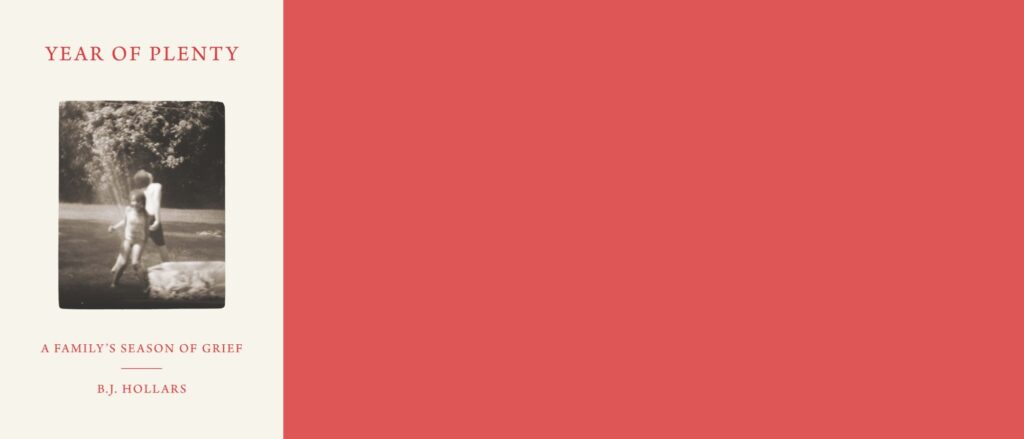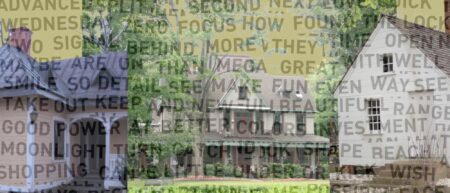A review of B.J. Hollars’ Year of Plenty: A Family’s Season of Grief
Grief—all kinds, any kind—is a monumentally complex experience. How does one even begins to write a book about grief? Where does the personal experience end and the universal begin? What can one say that hasn’t been said before? How to explain the heartache of grief without sounding cliché or trite?
B.J. Hollars takes on this complex task in his new memoir Year of Plenty: A Family’s Season of Grief (University of Wisconsin Press, 2024). Hollar’s memoir opens with him receiving a concerning phone call while teaching at UW-Eau Claire—a fitting opening, as Hollars becomes our teacher. He begins to guide and instruct us through the stages and realities of actively losing a loved one, during the height of the pandemic, no less. In a second phone call, Hollars’ father-in-law Steve matter-of-factly confirms he is dying of stage four small cell lung cancer.
I connected with the book immediately because of my own experience with grief, something so many of us know intimately and others will come to understand. Having just met grief and knowing the difficulty of the subject, I still found Hollars’ memoir is easily consumable because of its form: stories, stories, and more stories, most in a diary-like format that includes timestamps and short, transcribed interviews.
Unlike Hollars, I am not losing my mother to a cancer that ends her life, but to dementia that stalls it and takes her away from me, piece by piece. I still understood his reliance on stories. My life with my mother was really just a patchwork of experiences that, when sewn together, created our complicated history. Hollars’ form grounds his narrative, allows us to know the author, his wife, their children and extended family, and importantly, his father-in-law. I found myself recognizing this friendly and warm family. They were my neighbors, parents I see at school events, people from church with whom I might chat weekly.
The backdrop of the Midwest—my home for most of my life—also plays an important role in the telling of this family’s story. As the Hollars strive for normalcy during their season of grief, they hike and kayak throughout Wisconsin and go to summer evening minor league baseball games. They gather in backyards in Indiana, they catch lightning bugs, they fish with grandpa. The most heartfelt setting of the book is Steve’s coffee shop—in part because it is almost impossible to imagine that places like this exist anymore. Here, in the no-frills shop, Steve’s elderly friends gather for camaraderie and trading stories (often about fishing), where sometimes there is food on the menu (cheese sandwiches) but often there is not. The kindness, the wholeness of the entire family structure seems as if it could only take place in the settings that Hollars depicts, which are almost stand-alone characters themselves.
They are the Hollars, but they are Everyfamily. We learn that the Hollars are both ordinary and extraordinary, as we follow along with the daily joys and frustrations of marriage, children, and aging parents, and also watch them experience these same joys and frustrations as they navigate an oncoming, inevitable death of a beloved father and grandfather.
I feel the world spinning, regardless of the inevitability of my mother’s illness and impending death, and the loss that comes afterward. As I navigate my own mother’s decline, as I struggle with balancing a constancy of patience and resentment over being a long-term caretaker. I, like the Hollars, continue to experience my own daily joys and frustrations, to move through the motions of life, while many of those around me do not fully know or understand the grief that resides within me.
Others don’t understand that we have to navigate decisions not based on rationality, but emotion. Early in the book, Hollars and his wife Meredith contemplate a trip to Florida with Steve to spend dedicated quality time together, knowing that they won’t have this opportunity again. The difficult decision to travel is compounded because of COVID-19 and its risks. Hollars writes, “I should have said, ‘I understand.’ Instead, I say: ‘Are you kidding? You want to take our kids on a plane in the pandemic?’…Do we risk the children’s safety so they might spend some time with their grandfather in the place he loved the most? Or do we play it safe…and lose that time forever?”
Hollars then walks the dog for hours (until the dog refuses to walk any further) and he reaches a decision: “I mean, the world couldn’t be that cruel, right?” he says to his wife as he concedes the trip over caution, and she replies, “It could be.” The scene isn’t melodramatic, isn’t infused with passionate, colorful dialogue; it simply rings true—this is how couples who communicate well make hard decisions, in fits and starts and in simple terms, even when nothing at stake is black and white.

Hollars takes us by the hand and guides us through the many ways that we will meet grief: when it takes away the anchor of our parents and our childhood homes; when it confronts our children through their first loss; when it makes us find empathy for the grieving process of others; and when it forces us to accept the often-maddening reality that life keeps moving despite our circumstances. Hollars narrates these moments effectively and shares examples that we can connect with: feeling guilt that our own parents are still alive when a partner has lost both of hers, marveling that our parents have had lives and experiences (many that we don’t learn about until much later—these are always the kickers) before we knew them, and finding solace in the innocent reactions of children.
Hollars is a strong narrator as he leads his readers to grief, through grief, and beyond grief, because he allows the reader to breathe in each stage. Even with his stories and vignettes, his pacing is slow and purposeful, his voice honest and kind. By the time the book ends, I felt connected to the Hollars family and was journeying with them as they moved forward—they literally move into a new home at the end of the book—past their year of grief. Hollars has the gentle voice that calls a reader like me in, a reader who has met grief, knows what it feels like, how it changes us.
Year of Plenty is a quiet book, a personal book, an honest book. B.J. Hollars, ever the teacher, lays groundwork for his readers, offering one version of what mindful dying looks like—not just for the one who is sick, but for everyone who loves him. I feel everyone who has, is, or will experience grief—and this, of course, is all of us—should let Hollars guide us through it.
—
After 30 years of helping young people with their writing as a high school English teacher, Pam Anderson retired and decided to dedicate time to her own work. She completed her MFA in creative nonfiction at the University of Nevada-Reno/Lake Tahoe. Her essays, interviews, and criticisms have appeared in HEAL, Wisconsin Creative, HerStry, Tolsun anthology The Book of Life After Death, Bookends Review, Chicago Review of Books, and more.



